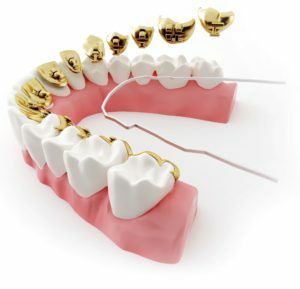 A beautiful smile often becomes a visiting card, so today many seek to correct existing bite defects and irregularities of the dentition.
A beautiful smile often becomes a visiting card, so today many seek to correct existing bite defects and irregularities of the dentition.
To make the treatment imperceptible for others let lingual braces, which got their name according to the uncharacteristic for bracket-systems arrangement - on the inside of the teeth in the immediate vicinity of the language( in English, "lingua" means language).
For the first time such a system of correction of the dentition was applied in the 80s of the last century, but unlike modern designs, it caused a lot of inconvenience in talking and eating( some patients even rubbed a painful callus on the tongue).
Design feature
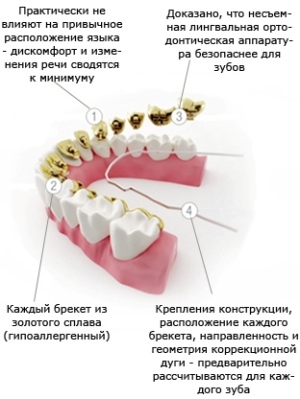
Description of lingual bracketsfor example Incognito
apparatus lingual bracket systems substantially similar to the systems of correction set by the outside teeth.
The main elements are braces in the form of small plates, attached with a special composition to the surface of the teeth. In each bracket, there is a base and a slot in the middle part, into which the arc is passed.
As the device is worn, the arc is replaced, correcting the load created on the teeth. At the very beginning, an arc of maximum elasticity with a circular cross section is used.
After some time it is replaced by an analog of a larger diameter. The last step of the correction involves setting the arc of a square section. The support for the arc is an orthodontic ring equipped with a lock, mounted on the 6th or 7th tooth.
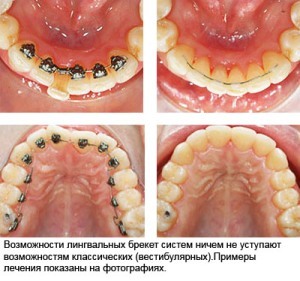 In terms of aesthetics, called "invisible" lingual braces are an ideal option, but still have some inconveniences.
In terms of aesthetics, called "invisible" lingual braces are an ideal option, but still have some inconveniences.
It is about adapting to a system that takes place with such uncomfortable phenomena accompanying the process as abundant salivation, possible traumas of the tongue and mucous as a result of the bite, the sensation of a foreign body in the mouth. As practice shows, the maximum duration of the adaptation period does not exceed 4 weeks.
The installation of lingual braces can be carried out by an orthodontist only if appropriate skills are available, as this procedure implies special pre-training.
Installation and operation principle
Due to the peculiarities of the placement of the lingual bracket system, its installation is associated with certain difficulties. In comparison with the external, the inner surface of the teeth is full of bends and tuberosity, therefore, it is shown that manufacturing bracket systems in an individual order to obtain the most optimal points of location on the teeth.
Features of the
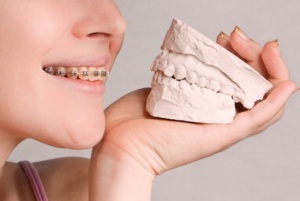 At the initial stage, the impression is taken from the patient's teeth( a full impression of the jaw is required for a competent evaluation).
At the initial stage, the impression is taken from the patient's teeth( a full impression of the jaw is required for a competent evaluation).
In the laboratory, on the available imprint, a model of the dentition is created, which it should ideally be. It is for this ideal model that wax copies of internal braces are made.
Thus each lock is done on each tooth in an individual order. The obtained wax copies are attached in the correct order to the mold, and then the model is plastered with gypsum.
The wax is then melted and filled with molded molten gold, forming ready braces.
Ready-made designs are important to deliver to the patient unchanged, so they are stored in special kappa for transfer.
Installation of the device on the seat
The installation of the lingual bracket system usually takes at least three hours. Such a long time period is explained by the need to accurately set each lock for fast and effective bite correction.
Patients who decide to do this should be prepared for frequent visits to the orthodontist dentist according to a strictly established schedule for assessing the progress and condition of the teeth, and correcting the arc.
Kinds of
devices Modern lingual braces are represented by the basic two types:
- Classical ligature systems - the design features include the flap-wings present on the side of the flap fasteners for the fastening filaments of the ligature threads. Because of the stretching during the treatment, the ligature is changed monthly.
- Unshielded - with a self-locking mechanism in the bracket for strong arc locking.
Also, lingual bracket systems differ depending on the chosen model.
Incognito
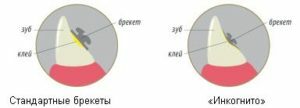 Differ the highest cost and at the same time the maximum comfort when wearing. It is possible to achieve the required result in the shortest possible time due to individual manufacture taking into account the structure of the jaw of a particular patient.
Differ the highest cost and at the same time the maximum comfort when wearing. It is possible to achieve the required result in the shortest possible time due to individual manufacture taking into account the structure of the jaw of a particular patient.
Gold is chosen as the material of the locks, therefore, an allergic reaction is excluded.
On 1 and 2 photos you can consider their appearance.
Flat system Forestadent 2d
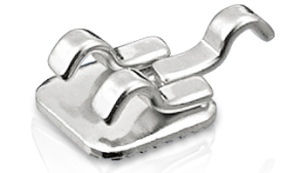 Suitable for minor bite disorders. Thanks to the flat design, the brackets are easy to install and comfortably worn.
Suitable for minor bite disorders. Thanks to the flat design, the brackets are easy to install and comfortably worn.
They are produced in sets with sets of self-ligating pads and arches( all parts have a smooth surface and rounded corners).
Characterized by the minimum cost.
In-Ovation L-free systems
Manufacturer - American company GAC.The bracket system is adhesive-free, so it is easy to install in the oral cavity. As alloy materials, titanium and nickel alloys act along with gold.
These bite correction systems can be used only if the following conditions are met:
-
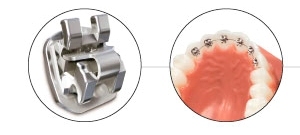 the central line of the dentition row is displaced by no more than 2 mm;
the central line of the dentition row is displaced by no more than 2 mm; - adjacent teeth are separated from each other by a distance of at most 3 mm;
- tooth density does not exceed 6 mm;
- teeth are twisted at a maximum of 25 degrees.
Metal constructions stb
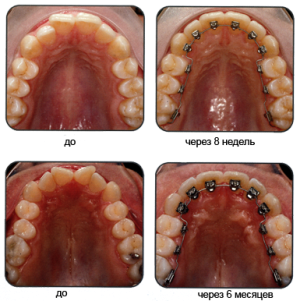
Manufacturer - American company ORMCO.For these systems is characterized by the most affordable price and the minimum size of the locks, due to what discomfort when wearing almost does not arise.
The miniature size is both a virtue and a disadvantage, because due to the small adhesion area, the locks often get peeled off from the tooth surface.
The fabrication material can be nickel-titanium alloy or medical steel.
Left before and after treatment with internal STB brackets.
Advantages of such solutions
Among other things, it is worth highlighting such advantages of lingual systems:
-

successful correction of of the most difficult cases of bite disorders, which are beyond the power of other braces( for example, reverse or deep bite);
- invisibility for others;
- rapid achievement of the result before the end of treatment;
- the ability to independently position the brace body, its hooks and bases thanks to the modular structure;
- more fast compared with other systems adaptation of , due to the miniature size of the locks;
- possibility of correction for patients professionally engaged in sports or music( playing on wind instruments).
There are also disadvantages of
Among other things:
-
 the long process of installing and the complexities arising from care;
the long process of installing and the complexities arising from care; - discomfort during the adaptation period , manifested by the inconvenience of eating, lisp, as a rule, such phenomena completely disappear after two weeks from the moment of braces fixation;
- the need for to refuse a number of food products, including toffee and caramel, hard food, carbonated drinks; -you can not use chewing gum throughout the treatment;
- frequent visits to the hygienist due to the constant ingress of food particles under lock-up, which can not be cleaned out on their own due to the inconvenience of the arrangement of the braces.
In some cases, during the treatment period, it is necessary to increase pressure on the teeth. To do this, lingual braces are supplemented by other systems that are worn in the evening or worn at night.
In addition, at the end of the correction, the result is fixed using removable or non-removable containers.
Contraindications for the installation of
Such systems should not be used when:
-
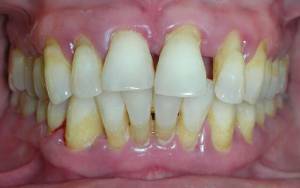
Parodontosis
narrow jaw, due to which the patient can not adapt to the installed locks;
- excessive crowding of teeth;
- small crown height;
- the presence of periodontal disease and other gum diseases, the treatment of which takes time;
- violations of the temporomandibular joint;
- disease on the background of an allergic reaction;
- mental disorders, including epilepsy;
- aged patients under 11 years of age( due to not fully formed dentition);
- inability to comply with personal oral hygiene.
Care for the
 System To maintain the teeth with the lingual brackets installed on them, you need special orthodontic brushes, model-brushes or electrical analogues.
System To maintain the teeth with the lingual brackets installed on them, you need special orthodontic brushes, model-brushes or electrical analogues.
Because of the inconvenience of using toothpicks and dental floss, an alternative is used in the form of irrigators - devices from which a thin stream of water with air bubbles is supplied under pressure to clean the surface of the teeth and the elements of the system.
Tips from the experienced
According to the patient's feedback, wearing lingual braces delivers unpleasant sensations during the first days after installation. To judge the effectiveness of correction and features of use can be on the following statements.
Natalia
Ludmila
Karina
Price of the issue
This is the main indicator for many, and a significant disadvantage. It should be noted that the cost of manufacturing and installation depends not only on the clinic, but also on the region in which the patient is located.
As an example, the approximate cost of different stages of the procedure in the clinics of Moscow:
-
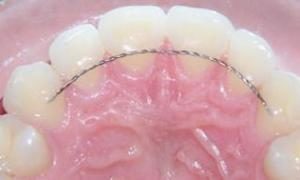
manufacturing of lingual bracket systems for one jaw - about 60 thousand rubles;
- installation of manufactured locks on one jaw - 20 thousand rubles;
- preventive examinations in the orthodontist's office when installing braces for one jaw - about 5 thousand rubles;
- removal of corrective design - 4 thousand rubles;
- manufacture and installation of a retainer( correction system used after the end of treatment to fix the result) to one jaw - 6 thousand rubles.
These prices are indicative and may vary in each specific case, depending on the model of the selected lingual correction system, material used and the amount of work.
More information about invisible braces will be told by an orthodontist:
The alignment of teeth with the help of internal braces can be carried out regardless of age and sex. The main thing is to be morally tune up for long-term treatment and some difficulties associated with getting used to the system and caring for it.
In children, the result is achieved much more quickly, whereas for adult patients it may take several years to achieve maximum effect.
But, as they say, beauty requires victims, which in this case are minimal in comparison with the use of outdoor systems. So an ideal smile will be provided with minimal discomfort.
